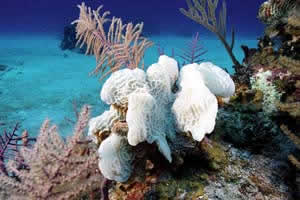
This fire coral in the Turks and Caicos Islands shows its normal color. (Photo courtesy Tom Fretz)

This fire coral in the Turks and Caicos Islands is bleached out. (Photo courtesy Tom Fretz)
Survival strategies for coral reefs and mangroves threatened by climate change are outlined by scientists of IUCN-World Conservation Union and the Nature Conservancy in two new publications launched today. The strategies rely on managing stressors other than global warming so that corals and mangroves are more resilient and able to survive in a warming world.
Climate change is destroying tropical marine ecosystems through sea temperature increase and ocean acidification. Scientists say 20 percent of the world's coral reefs have already been ruined and a further 50 percent are facing immediate or long term danger of collapse.
Yet, one of the reports published today shows that saving the world's coral reefs may still be possible. By fighting other stress factors such as pollution or overfishing impacting coral reefs, the reefs will be able to better adapt to climate change impacts, according to the report, "Coral Reef Resilience and Resistance to Bleaching."
Another report by the two organizations, "Managing Mangroves for Resilience to Climate Change" follows a similar strategy. To help mangroves and corals survive in the face of climate change, the two reports publish a series of strategies and tools to fight the other stress factors impacting on them.
Both publications are part of a new IUCN series on climate change and coral reefs.
"The two reports give a clear positive message: while we cannot stop climate change in the short term, we can help tropical marine ecosystems survive," said Carl Gustaf Lundin, head of the IUCN Global Marine Programme. "If reef managers and politicians follow the measures proposed in these publications, we may be able to reverse the trend."
Increased sea surface temperatures and ocean acidification due to higher levels of dissolved carbon dioxide, CO2, are leading to increased mass coral bleaching and mortality, reduced growth of corals and weakened animal skeletons.
Rapid sea level rise, more violent tropical storms and changes in rainfall and salinity occurring as the planet warms are also affecting coral reefs and mangroves.
"We need to minimize human impacts such as pollution, overfishing or unsustainable coastal development. Then the coral reefs have a bigger chance of coming back after bleaching and of adapting to rising sea temperatures or more acid waters," said Gabriel Grimsditch of the IUCN Global Marine Program, one of two authors of the publication on coral reefs.
Other measures include protecting areas of particularly healthy sites that are resilient in the face of climate change. These sites may be able to help regenerate degraded coral reefs and mangroves in the future.
Monitoring of coral reefs before, during and after a bleaching event will help to raise awareness amongst managers and politicians, the reef report suggests.
Coral reefs only cover 0.2 percent of the ocean floor, but contain 25 percent of marine species globally. Coral reefs provide livelihoods to 100 million people and provide the basis for industries such as tourism and fishing, worth an annual net benefit of US$30 billion, the report states.
One hectare of mangroves is estimated to deliver products and services worth up to $900,000. Examples of these products and services include timber and wood chips, an environment for fish spawning, and habitat for economically important species.
But climate change is compromising these ecosystems' ability to deliver benefits to plants, animals and humans in the future.
"Rising temperatures and sea levels challenge reef managers to be flexible and adapt their approaches to make the reefs and mangroves under their care more resilient to climate change as new science and understanding emerges," says Rodney Salm, director of the Transforming Coastal Marine Conservation Program at the Nature Conservancy, and the other co-author of the coral reef resilience publication.
At the Third International Tropical Marine Ecosystems Management Symposium which took place October 15 to 20 in Cozumel, Mexico, over 300 delegates from 45 countries concluded that sea temperature increase must be limited to two degrees Celsius above pre-industrial levels if major damages to tropical ecosystems are to be avoided.
In their final Action Statement, the delegates recommended, "Management planning must incorporate recognition that mass coral bleaching, will have the potential for similar social and economic consequences as other environmental such as droughts, oil spills and other disasters, and will require similar responses."
Contingency plans must be developed according to the nature of coastal areas which will provide for proper coordination at the regional, national and local level before, during and after a disaster, the delegates advised.
Tropical nearshore and coral reef fisheries are generally not well managed, the delegates said. They recommend supporting reform of fishery governance at multiple levels to harmonize policies to ensure consistency, sustainability and integration of fisheries management with other elements of tropical marine ecosystem management.
Long-term financial planning and monitoring for revenue generation, funds management, and expenditure should be fundamental to all coastal management activities, the delegates said.
"It is high time for action," says Lundin. "That is the clear message expressed by scientists at this symposium and around the world. IUCN therefore works to identify the best science and offer practical solutions to policymakers and conservation managers, which is the goal of these manuals."
View the publications online:
"Coral Reef Resilience and Resistance to Bleaching," Gabriel D. Grimsditch and Rodney V. Salm: http://www.iucn.org/dbtw-wpd/edocs/2006-042.pdf
"Managing Mangroves for Resilience to Climate Change," Elizabeth Mcleod and Rodney V. Salm: http://www.iucn.org/dbtw-wpd/edocs/2006-041.pdf
